#7: CHEOPS telescope arrives at new home
4 May 2017
A major milestone for the CHEOPS mission was passed on 28 April 2017, when the telescope flight model was delivered to the University of Bern by Leonardo-Finmeccanica, on behalf of the Italian Space Agency (ASI) and the Italian National Institute for Astrophysics (INAF).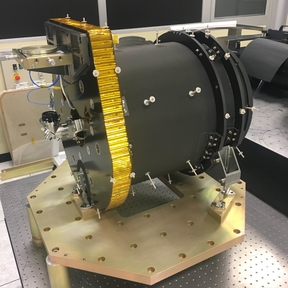 |
| The CHEOPS telescope tube and optical bench. Credit: Leonardo-Finmeccanica |
CHEOPS will perform ultra-high precision photometry on bright stars already known to host exoplanets with typical sizes ranging from Neptune down to that of Earth. It will allow accurate sizes of these exoplanets to be measured for the first time by monitoring how much dimming they cause as they pass between their host stars and the telescope. The CHEOPS telescope has been carefully designed, manufactured, and tested with this scientific objective in mind, and its delivery marks the end of 4 years of intense activity by a multinational team.
The delivered hardware consists of the telescope tube assembly (TTA), integrated with the telescope mirrors and back-end optics that will focus starlight onto the CCD detector. The TTA not only supports the optical elements, but is also the structural core of the payload onto which various subsystems – such as the star trackers, the instrument radiator, the baffle, and the focal plane module – will be mounted.
The CHEOPS instrument is built around a Ritchey-Chrétien telescope, the same optical design used for the larger NASA/ESA Hubble Space Telescope. Light from exoplanet host stars will enter the telescope and be reflected by a 320-mm hyperbolic primary mirror towards a 68-mm hyperbolic secondary mirror mounted on the central axis of the telescope tube. The secondary mirror will direct the starlight through a hole in the centre of the primary mirror, where the back-end optics will re-image the telescope focal plane onto the CHEOPS CCD detector.
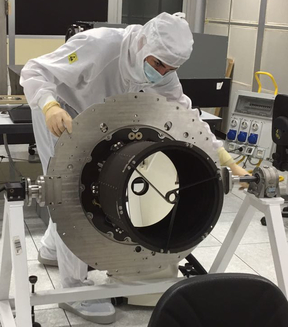 |
| Integrating and aligning the CHEOPS telescope mirrors. Credit: Leonardo-Finmeccanica |
The change in the measured host star brightness that the transit of an Earth-size planet across the disc of a G5 dwarf star introduces is at the level of 100 parts in one million. To be able to measure such tiny changes in a robust and statistically significant way, the measurement uncertainty or noise introduced by the instrument itself needs to be even smaller, at the level of 20 parts per million. This degree of photometric precision imposes stringent requirements on the amount of stray light allowed to reach the detector, and on the stability of the optical performance as the temperature varies. In addition, it is important to ensure that the operation of the onboard electronics does not cause interference that affects optical flux measurements.
The black TTA structure comprises the telescope tube containing the primary and secondary mirrors, and an optical bench at the rear for supporting the back-end optics and focal plane module.
CHEOPS will operate in a near-Earth orbit, where variations in temperature can be significant, so the telescope tube will be temperature-controlled – it has, however been tested for temperature variations in the range -5 to -15 °C.
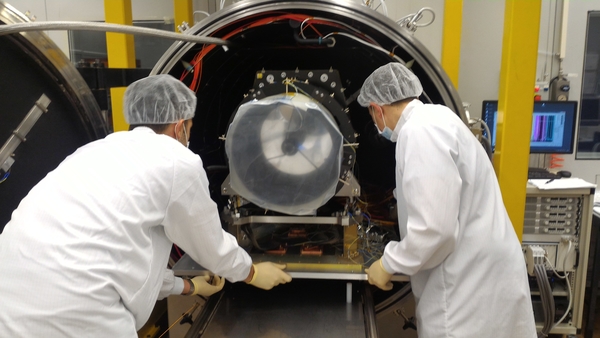 |
| Testing the CHEOPS telescope. Credit: Leonardo-Finmeccanica |
A key requirement of the mission is that thermal expansion and contraction of the support structure does not cause misalignment of the optical elements resulting in distortions of the images and inconsistent flux measurements. This requirement has been met by manufacturing the telescope structure from carbon-fibre reinforced plastics (CFRP) to achieve a strong, light, and thermally stable design. Since the thermoelastic properties of a CFRP laminate depend on the orientations of the individual laminae, Swiss company Almatech, which was responsible for the TTA structure, designed it down to the lamina level. Finite-element modelling using a 450 000-element model of the entire structure was combined with test sample measurements to select the orientations and stacking sequence of the laminae. The thermal stability of the manufactured structure was then verified with a dedicated test in space-like thermal and vacuum conditions using highly-accurate interferometric measurements.
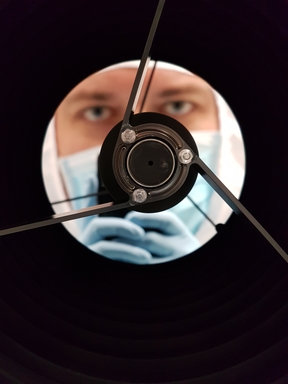 |
| Looking into the CHEOPS telescope tube. Credit: University of Bern, T. Beck |
After the telescope structure was delivered to Leonardo-Finmeccanica in Florence, the integration of the mirrors and back-end optics – also manufactured by Leonardo-Finmeccanica – took place. The high-precision optics were then aligned using interferometric techniques, after which the optical system was characterised under simulated in-orbit conditions in a thermal-vacuum chamber. In particular, the precise position of the focal plane was established so that the CCD detector can be placed accurately when the focal plane module is mounted.
To reach the low noise levels required to achieve the science goals of the mission, it is important that the only light arriving at the CHEOPS detector should be that from the star itself, and that light reflected by surfaces within the instrument is kept to a minimum. Both the baffle and the field stop in the back-end optics have been designed to reject this stray light. However, stray light effects can also result from contamination of the optics, and therefore very stringent cleanliness requirements were applied during integration and alignment of the optics. The CHEOPS telescope baffle assembly has a cover to guard against contamination – this is kept closed for almost all further integration activities and will be opened once CHEOPS is in orbit.
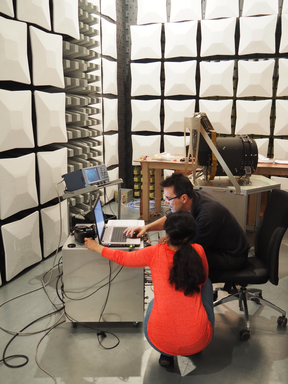 |
| CHEOPS testing. Credit: University of Bern |
In parallel with the telescope activities, in March, team members from the University of Bern performed electromagnetic compatibility (EMC) testing of an electrical qualification model of the instrument at the EMC-Testcenter AG in Regensdorf. These tests were carried out to confirm that the electronic subsystems of the instrument are compatible with the electromagnetic environment during launch, and to verify that spacecraft operations and science data are not adversely affected by electromagnetic emission from onboard electronics such as the onboard antennae and payload heaters. The test results showed that the instrument complies with the EMC requirements. Integration of the electronic components in the payload can now proceed with confidence.
Much effort has gone into ensuring that CHEOPS will have a steady gaze, free from electromagnetic interference, thermally-induced artefacts, and stray light, as it stares at the pale shadows of distant exoplanets. The optical and structural core of the payload has completed its journey from Florence, over the Alps, to Bern and a new phase of integration work can now begin.
About CHEOPS
CHEOPS is an ESA mission implemented in partnership with Switzerland, through the Swiss Space Office (SSO). The University of Bern leads a consortium of 11 ESA Member States contributing to the mission and represented in the CHEOPS Science Team. ESA is the mission architect responsible for overall mission definition and procurement of the spacecraft and launch. ESA is also responsible for early operations phase that will be executed by the spacecraft contractor, EADS CASA Espacio S.L., which is part of Airbus Defence and Space. The science instrument is led by the University of Bern, with important contributions from Austria, Belgium, Germany and Italy. Other contributions to the science instrument, in the form of hardware or science operations, are provided by Hungary and by France, Portugal, Sweden and the United Kingdom respectively. CHEOPS will be launched from Europe's spaceport in Kourou, French Guiana, on a Soyuz rocket operated by Arianespace. Following successful in-orbit commissioning of the spacecraft, responsibility for operations will be taken over by the CHEOPS Mission Consortium, with the Mission Operations Centre under the responsibility of Spain and the Science Operations Centre led by and located at the University of Geneva, Switzerland.






